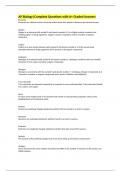Exam (elaborations)
AP Biology|Complete Questions with A+ Graded Answers
- Course
- Institution
AP Biology|Complete Questions with A+ Graded Answers Elements Elements are substances that cannot be broken down into simpler substances by chemical means. Oxygen Oxygen is an element with symbol O and atomic number 8. It is a highly reactive nonmetal and oxidizing agent. In living organism...
[Show more]



